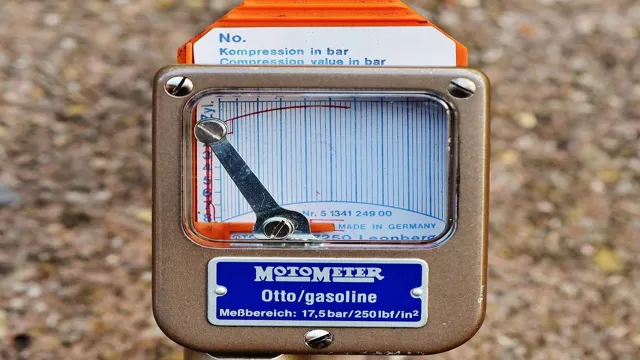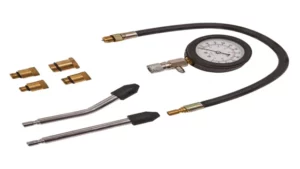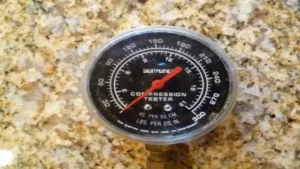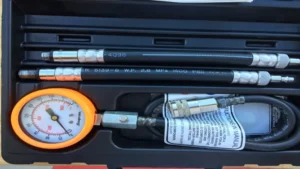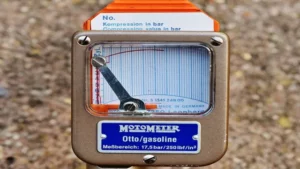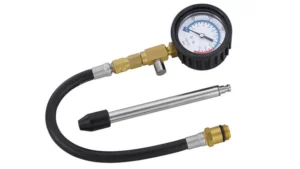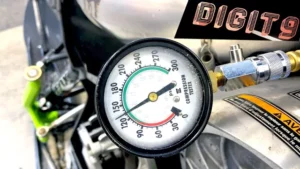If you’re a motorcycle owner, you know the importance of maintaining your ride to keep it in tip-top shape. One critical aspect of motorcycle maintenance is checking the engine’s compression. Low compression can lead to severe engine damage and reduced performance, ultimately leading to costly repairs or replacements.
To ensure your engine’s maximum performance, it’s essential to use a reliable compression tester to determine the engine’s compression level. In this blog post, we’ll discuss the benefits of using a compression tester for your motorcycle and how to use it properly. Whether you’re a seasoned mechanic or a beginner, this guide will help you understand the importance of regularly checking your engine’s compression.
What is a Compression Tester?
If you want to know how to use a compression tester for your motorcycle, first you have to understand what it is. A compression tester is a tool that measures the pressure in each cylinder of your engine. It’s important to use one to check the health of your engine and identify potential problems.
To use a compression tester, you’ll need to remove the spark plugs and attach the tester to one of the cylinders. Then, turn the ignition key and crank the engine a few times to get a reading of the pressure. Repeat this process for each cylinder.
The pressure reading will tell you if there are any issues with your engine, such as a leaking head gasket or worn piston rings. By regularly using a compression tester, you can keep your motorcycle in good shape and catch any problems before they become serious. So, don’t hesitate to give it a try!
Measuring the Compression
A compression tester is a tool used to measure the pressure generated by an engine’s pistons during compression strokes. This process helps diagnose potential engine problems, such as worn piston rings or leaking valves, by measuring the engine’s ability to generate and maintain pressure. The tool is straightforward to use and provides immediate results, making it an essential part of any mechanic’s equipment.
When using a compression tester, the engine must be at operating temperature, and all the spark plugs should be removed. The tester is then screwed into the spark plug hole, and the engine is cranked over for several seconds to get an accurate reading. The results can be compared to the manufacturer’s specifications to determine if there are any issues that need to be addressed.
By regularly using a compression tester, you can identify and resolve potential engine problems before they become more severe, saving you time and money in the long run.
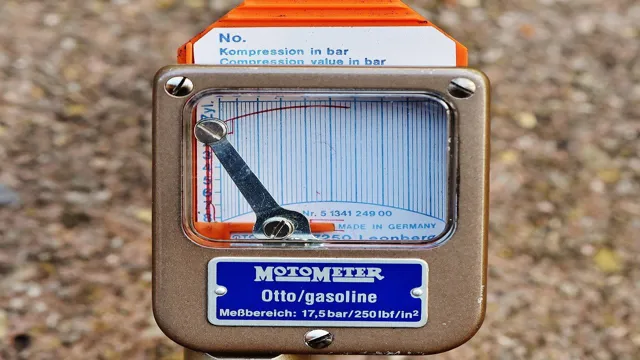
A Step-by-Step Guide to using a Compression Tester on your Motorcycle
A compression tester is a tool that is used to measure the compression pressure of an engine’s cylinders. This is an essential tool for any motorcycle enthusiast, as it allows you to diagnose engine problems such as low compression, worn piston rings, or stuck valves. The tester is typically inserted into the spark plug hole, and the engine is cranked over while the pressure is measured.
The pressure reading can then be compared to the manufacturer’s specifications to determine if the engine is running properly. In order to use a compression tester, you’ll need to remove the spark plug from each cylinder one at a time and then thread the tester into the spark plug hole. It’s important to ensure that the tool is properly seated and to follow the manufacturer’s instructions carefully.
By using a compression tester, you can ensure that your motorcycle is running at peak performance and catch any problems before they become major issues.
Locating the Spark Plug
When it comes to locating the spark plug in your car, it can be a challenging task, especially if you are not familiar with the engine’s layout. The spark plug’s primary function is to ignite the air/fuel mixture in your car’s combustion chamber. Knowing the spark plug’s location is essential, particularly when checking its condition to ensure your car’s engine runs smoothly.
One tool that can help you check your spark plug’s condition is a compression tester. It measures the engine’s compression to accurately determine the health of your spark plug and other engine components. A compression tester can help you spot common engine problems such as low compression, worn piston rings, or even leaky valves.
Therefore, it’s essential to have a compression tester and learn how to use it correctly to keep your car running smoothly and prevent expensive engine repairs in the future.
Removing the Spark Plug
A compression tester is an essential tool that is used to check the compression pressure of an engine’s cylinders. It measures the amount of pressure produced when the piston compresses air and gasoline mixture inside the cylinder before it explodes. A low compression reading can indicate several issues with the engine, such as worn out piston rings, cylinder walls, or faulty valves.
To use a compression tester, remove the spark plug from the engine and attach the tester to the spark plug hole. Then crank the engine, and the gauge on the tester will display the amount of compression. It’s important to have an accurate reading to diagnose any potential engine problems.
By using a compression tester, you can identify any underlying issues that may affect performance, fuel efficiency, and engine life. So don’t ignore engine issues and invest in a compression tester to keep your engine running smoothly.
Screw-in the Compression Tester
A compression tester is a tool that is used to test the compression of an internal combustion engine. Essentially, it measures the pressure inside the engine cylinder during the compression stroke. This is important because it can give you an idea of the engine’s overall health and performance.
If there is low pressure, it can indicate issues such as worn piston rings or valves, which can lead to decreased power and even engine failure. So, how do you use a compression tester? First, screw it into the spark plug hole of the cylinder you want to test. Then, crank the engine over a few times with the ignition disabled.
The gauge on the tester will show you the pressure reading. It’s a simple process that can give you valuable information about your engine’s condition.
Testing the Compression
A compression tester is a tool used to measure the compression levels of an engine cylinder. It is an essential tool for automotive mechanics as it helps to diagnose engine problems and assess the health of the engine. The compression tester works by screwing it into the spark plug hole of the engine and then cranking the engine to measure the compression level.
A low compression level can indicate problems with the engine, such as worn out piston rings, damaged valves, or head gasket issues. Testing the compression is an important step in engine diagnostics, as it can help to identify potential issues early on, saving both time and money in the long run. Therefore, having a compression tester as part of your toolset is a valuable investment for any car mechanic.
Interpreting the Results
A compression tester is a tool used to measure the pressure that an engine generates when it is running. It is one of the most important tools in a mechanic’s arsenal, as it can help diagnose issues with the engine’s internal components. When an engine is operating, it generates a certain level of compression, which can be measured using the compression tester.
By analyzing the results of the compression test, you can determine whether the engine is operating as it should or whether it has issues that need to be addressed. Low compression can be an indication of a variety of issues, including worn or damaged piston rings, valve leaks, or faulty head gaskets. These issues can cause poor engine performance, reduced fuel efficiency, and even engine failure if left unaddressed.
In short, the compression tester is an essential diagnostic tool that can help ensure the longevity and reliability of your vehicle’s engine.
Final Thoughts
Using a compression tester for your motorcycle is a simple task that can help diagnose issues with your engine. To get started, you’ll need to remove the spark plug from the cylinder you’re testing and attach the compression tester to the spark plug hole. With the throttle fully open and the engine warmed up, crank the engine a few times to get a reading.
A healthy engine should have a compression reading within the manufacturer’s specifications. If it’s low, you may have worn or damaged piston rings, valve seats, or gaskets. Overall, testing your motorcycle’s compression can save you time and money by helping you identify problems early and addressing them promptly.
So grab your compression tester, and get to testing!
Conclusion
In conclusion, using a compression tester on your motorcycle is like giving it a doctor’s check-up. It’s a simple process that can save you from costly repairs down the road. Just remember to warm up your engine, remove the spark plugs, and follow the instructions in your user manual.
And if you’re feeling adventurous, you can always add a little personality to the process by naming your compression tester. After all, a little humor can go a long way in the world of mechanics!”
FAQs
What is a compression tester for a motorcycle and how does it work?
A compression tester is a tool used to measure the compression pressure in a motorcycle engine. It works by screwing into the spark plug hole and measuring the pressure as the engine is cranked.
Why is it important to check compression in a motorcycle?
It is important to check compression in a motorcycle to ensure the engine is functioning properly and to diagnose potential issues such as worn piston rings or valves that may need to be replaced.
How do I prepare my motorcycle for a compression test?
To prepare your motorcycle for a compression test, remove the spark plugs and disconnect the fuel and ignition system. It is also recommended to warm the engine up before testing.
What should the compression reading be for a healthy motorcycle engine?
The compression reading for a healthy motorcycle engine typically ranges from 120-160 PSI, but this can vary depending on the make and model of the motorcycle and the altitude.
What are some causes of low compression in a motorcycle engine?
Some causes of low compression in a motorcycle engine include worn or damaged piston rings, warped or cracked cylinder head, burned or bent valves, or a blown head gasket.
Can a compression test be done on a motorcycle with an electric starter only?
Yes, a compression test can be done on a motorcycle with an electric starter only, by using a remote starter switch to crank the engine.
How often should I check the compression in my motorcycle engine?
It is recommended to check the compression in your motorcycle engine at least once a year, or more frequently if you notice any symptoms of engine problems such as decreased performance or difficulty starting.
